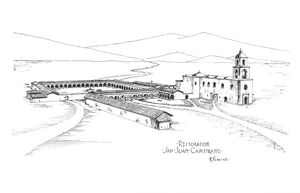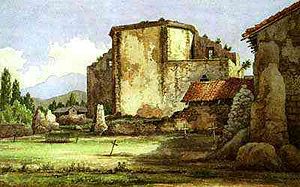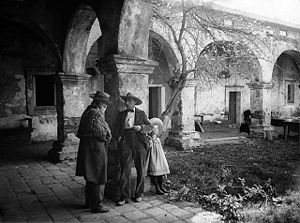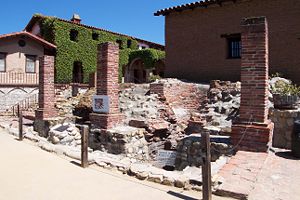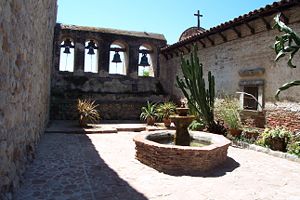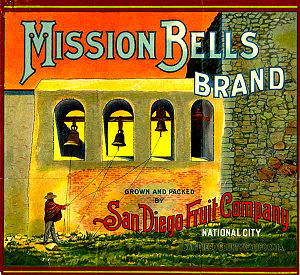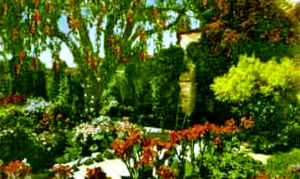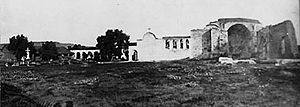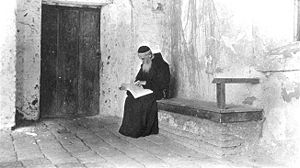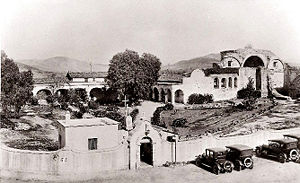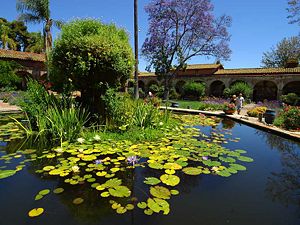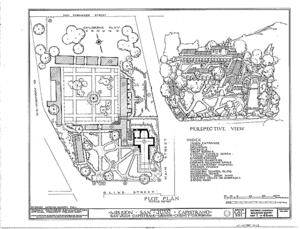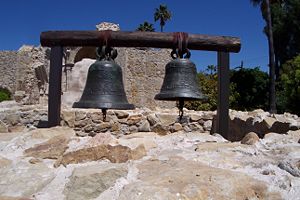Mission San Juan Capistrano: Difference between revisions
imported>Robert A. Estremo m (→Notes) |
imported>Robert A. Estremo |
||
| Line 46: | Line 46: | ||
Work was begun on "The Great Stone Church" (the only chapel building in Alta California not constructed out of adobe) on February 2, 1797. It was laid out in the shape of a cross, measuring 180 feet (55 meters) long by 40 feet (12 meters) wide with 50-foot (15 meter) high walls, and included a 120-foot (37 meter) tall ''campanile'' (bell tower) located adjacent to the main entrance.<ref>Krell, pp. 154, 275: The cruciform design is shared only with the extant chapel at [[Mission San Luis Rey de Francia]], which makes the two structures unique among the Alta California missions in this regard.</ref> Local legend has it that the tower could be seen for ten miles (16 km) or more, and that the bells could be heard from even farther away.<ref>O'Sullivan, p. 14</ref> The sandstone building sat on a foundation seven feet thick. Construction efforts required the participation of the entire ''neophyte'' population. Stones were quarried from gullies and creek beds up to six miles (10 kilometers) away and transported in carts (''carretas'') drawn by oxen, carried by hand, and even dragged to the building site. Limestone was crushed into a powder on the Mission grounds to create a mortar that was more erosion-resistant than the actual stones. On the afternoon of November 22, 1800 tremors from the 6.5-magnitude San Diego Earthquake cracked the walls of the rising edifice, necessitating that repair work be performed.<ref>Engelhardt 1922, p. 39</ref> Unfortunately, Señor Aguilár died six years into the project; his work was carried on by the padres and their charges, who made their best attempts to emulate the existing construction. Lacking the skills of a master mason, however, led to irregular walls and necessitated the addition of a seventh roof dome. The church was finally completed in 1806, and blessed by Fray Estévan Tapís on the evening of September 7; a two-day long ''fiesta'' followed.<ref name="yenne75">Yenne, p. 75</ref> The sanctuary floors were paved with diamond-shaped tiles, and brick-lined niches displayed the statues of various saints. It was by all accounts the most magnificent in all of California and a three-day feast was held in celebration of this monumental achievement. Tragedy struck the settlement when on the morning of December 8, 1812 (the "Feast Day of the Immaculate Conception of the Blessed Virgin") a series of massive earthquakes shook Southern California during the first Sunday service.<ref>Ruscin, p. 72</ref> The 7.0-magnitude [http://www.data.scec.org/chrono_index/wrightwd.html Wrightwood Earthquake] racked the doors to the church, pinning them shut. When the ground finally stopped shaking, the bulk of the nave had come crashing down, and the bell tower was completely obliterated. Forty native worshippers who were attending mass and two boys who had been ringing the bells in the tower were buried under the rubble and lost their lives, and were subsequently interred in the Mission cemetery.<ref>Engelhardt 1922, p. 251</ref> This was the second major setback the outpost had suffered, and followed severe storms and flooding that had damaged Mission buildings and ruined crops earlier in the year. | Work was begun on "The Great Stone Church" (the only chapel building in Alta California not constructed out of adobe) on February 2, 1797. It was laid out in the shape of a cross, measuring 180 feet (55 meters) long by 40 feet (12 meters) wide with 50-foot (15 meter) high walls, and included a 120-foot (37 meter) tall ''campanile'' (bell tower) located adjacent to the main entrance.<ref>Krell, pp. 154, 275: The cruciform design is shared only with the extant chapel at [[Mission San Luis Rey de Francia]], which makes the two structures unique among the Alta California missions in this regard.</ref> Local legend has it that the tower could be seen for ten miles (16 km) or more, and that the bells could be heard from even farther away.<ref>O'Sullivan, p. 14</ref> The sandstone building sat on a foundation seven feet thick. Construction efforts required the participation of the entire ''neophyte'' population. Stones were quarried from gullies and creek beds up to six miles (10 kilometers) away and transported in carts (''carretas'') drawn by oxen, carried by hand, and even dragged to the building site. Limestone was crushed into a powder on the Mission grounds to create a mortar that was more erosion-resistant than the actual stones. On the afternoon of November 22, 1800 tremors from the 6.5-magnitude San Diego Earthquake cracked the walls of the rising edifice, necessitating that repair work be performed.<ref>Engelhardt 1922, p. 39</ref> Unfortunately, Señor Aguilár died six years into the project; his work was carried on by the padres and their charges, who made their best attempts to emulate the existing construction. Lacking the skills of a master mason, however, led to irregular walls and necessitated the addition of a seventh roof dome. The church was finally completed in 1806, and blessed by Fray Estévan Tapís on the evening of September 7; a two-day long ''fiesta'' followed.<ref name="yenne75">Yenne, p. 75</ref> The sanctuary floors were paved with diamond-shaped tiles, and brick-lined niches displayed the statues of various saints. It was by all accounts the most magnificent in all of California and a three-day feast was held in celebration of this monumental achievement. Tragedy struck the settlement when on the morning of December 8, 1812 (the "Feast Day of the Immaculate Conception of the Blessed Virgin") a series of massive earthquakes shook Southern California during the first Sunday service.<ref>Ruscin, p. 72</ref> The 7.0-magnitude [http://www.data.scec.org/chrono_index/wrightwd.html Wrightwood Earthquake] racked the doors to the church, pinning them shut. When the ground finally stopped shaking, the bulk of the nave had come crashing down, and the bell tower was completely obliterated. Forty native worshippers who were attending mass and two boys who had been ringing the bells in the tower were buried under the rubble and lost their lives, and were subsequently interred in the Mission cemetery.<ref>Engelhardt 1922, p. 251</ref> This was the second major setback the outpost had suffered, and followed severe storms and flooding that had damaged Mission buildings and ruined crops earlier in the year. | ||
[[Image:San Juan Capistrano 1880 painting.jpg|thumb|300px|right|{{San Juan Capistrano 1880 painting.jpg/credit}}<br/>''Misión San Juan de Capistrano''. The 1880 work depicts the rear of the ruined "Great Stone Church" as well as part of the mission's ''campo santos''. A portion of "Serra's Church" is also visible at right. Oil on canvas.]] | [[Image:San Juan Capistrano 1880 painting.jpg|thumb|300px|right|{{San Juan Capistrano 1880 painting.jpg/credit}}<br/>''Misión San Juan de Capistrano'' by Henry Ford Chapman. The 1880 work depicts the rear of the ruined "Great Stone Church" as well as part of the mission's ''campo santos''. A portion of "Serra's Church" is also visible at right. Oil on canvas.]] | ||
The padres immediately resumed holding services in Serra's Church. Within a year a brick ''campanario'' ("bell wall") had been erected between the ruins of the stone church and the Mission's first chapel to support the four bells salvaged from the rubble of the campanile. As the transept, sanctuary (''reredos''), and ''sacristia'' (sacristy) were all left standing, an attempt was made to rebuild the stone church in 1815 which failed due to a lack of construction expertise (the latter is the only element that is completely intact today). Consequently, all of the construction work undertaken at the Mission grounds thereafter was of a strictly utilitarian nature. Father José Barona and Father Boscana oversaw the construction of a small infirmary (hospital) building (located just outside the northwestern corner of the quadrangle) in 1814, "for the convenience of the sick." It is here that ''Juaneño'' medicine men used traditional methods to heal the sick and injured.<ref>Engelhardt 1922, p. 57</ref> Archaeological excavations in 1937 and 1979 unearthed what are believed to be the building's foundations. | The padres immediately resumed holding services in Serra's Church. Within a year a brick ''campanario'' ("bell wall") had been erected between the ruins of the stone church and the Mission's first chapel to support the four bells salvaged from the rubble of the campanile. As the transept, sanctuary (''reredos''), and ''sacristia'' (sacristy) were all left standing, an attempt was made to rebuild the stone church in 1815 which failed due to a lack of construction expertise (the latter is the only element that is completely intact today). Consequently, all of the construction work undertaken at the Mission grounds thereafter was of a strictly utilitarian nature. Father José Barona and Father Boscana oversaw the construction of a small infirmary (hospital) building (located just outside the northwestern corner of the quadrangle) in 1814, "for the convenience of the sick." It is here that ''Juaneño'' medicine men used traditional methods to heal the sick and injured.<ref>Engelhardt 1922, p. 57</ref> Archaeological excavations in 1937 and 1979 unearthed what are believed to be the building's foundations. | ||
Revision as of 20:42, 5 April 2008
- Another mission bearing the name San Juan Capistrano is located in San Antonio, Texas.
Mission San Juan Capistrano was founded on "All Saints Day" November 1, 1776 by Spanish Catholics of the Franciscan Order. Named for a 15th century theologian and "warrior priest" who resided in the Abruzzo region of Italy, San Juan Capistrano has the distinction of being home to the oldest building in California still in use, a chapel built in 1782; known alternately as "Serra's Chapel" and "Father Serra's Church," it is the only extant structure wherein it has been documented that the padre officiated over mass. One of the best known of the Alta California missions (and one of the few missions to have actually been founded twice — others being Mission San Gabriel Arcángel and Mission La Purísima Concepción) — the site was originally consecrated on October 30, 1775 by Father Fermín Lasuén, but was quickly abandoned due to unrest among the indigenous population in San Diego.
The success of the settlement is evident in its historical records. Prior to the arrival of the missionaries, some 550 natives were scattered throughout the local area; by 1790, the number of converted Christians had grown to 700, and just six years later nearly 1,000 "neophytes" (recent converts) lived in or around the Mission compound. 1,649 baptisms were conducted that year alone, out of the total 4,639 souls converted between 1776 and 1847. More than 2,000 former inhabitants (mostly Juaneño Indians) are buried in unmarked graves in the Mission's cemetery (campo santos). The remains of Father (later Monsignor) St. John O'Sullivan, who recognized the property's historic value and working tirelessly to conserve and rebuild its structures, are buried at the entrance to the cemetery on the west side of the property, and a statue raised in his honor stands at the head of the crypt. The surviving chapel also serves as the final resting place of three padres who passed on while serving at the Mission: Fathers José Barona, Vicente Fustér, and Vicente Pascual Oliva are all entombed beneath the sanctuary floor.
The Criolla or "Mission grape," was first planted at San Juan Capistrano in 1779; in 1783, the first wine produced in Alta California emerged from the Mission 's winery. The Mission entered a long period of gradual decline after secularization in 1833. Numerous efforts were made over the years to restore the Mission to its former glory, but none met with great success until the arrival of Father O'Sullivan in 1910. Restoration efforts continue, and "Serra's Chapel" is still used for religious services. About half-a-million visitors, including 80,000 school children, come to the Mission each year. And, while the ruins of "The Great Stone Church" (which was all but leveled by an 1812 earthquake) are a renowned architectural wonder, the Mission is perhaps best known for the annual "Return of the Swallows" which is traditionally observed every March 19 (Saint Joseph's Day). Mission San Juan Capistrano has served as a favorite subject for many notable artists, and has been immortalized in literature and on film numerous times, perhaps more than any other mission. In 1984, a modern church complex was constructed just north and west of the Mission compound; the design is patterned after the old stone church, and is twenty percent larger.
Precontact
The current prevailing theory postulates that Paleo-Indians entered the Americas from Asia via a land bridge called "Beringia" that connected eastern Siberia with present-day Alaska (when sea levels were significantly lower, due to widespread glaciation) between about 15,000 to 35,000 years ago. The remains of Arlington Springs Man on Santa Rosa Island are among the traces of a very early habitation in California, dated to the last ice age (Wisconsin glaciation) about 13,000 years ago. The first humans are therefore thought to have made their homes among the southern valleys of California's coastal mountain ranges some 10,000 to 12,000 years ago; the earliest of these people are known only from archaeological evidence.[1] The cultural impacts resulting from climactic changes and other natural events during this broad expanse of time were negligible; conversely, European contact was a momentous event, which profoundly affected California's native peoples.[2]

The territorial boundaries of the Southern California Indian tribes based on dialect, including the Cahuilla, Cupeño, Diegueño, Gabrieliño, Juaneño (highlighted), and Luiseño language groups.[3]
The former Spanish settlement at Sajavit lies within that area occupied during the late Paleoindian period and continuing on into the present day by the Native American society commonly known as the Juaneño;[4] the name denotes those people who were ministered by the padres at Mission San Juan Capistrano.[5] Many contemporary Juaneño, who identify themselves as descendents of the indigenous society living in the local San Juan and San Mateo Creek drainage areas, have adopted the indigenous term Acjachemen. Their language was related to the Luiseño language spoken by the nearby Luiseño tribe.[6] The Acjachemen territory extended from Las Pulgas Creek in northern San Diego County up into the San Joaquin Hills along Orange County's central coast, and inland from the Pacific Ocean up into the Santa Ana Mountains. The bulk of the population occupied the outlets of two large creeks, San Juan Creek (and its major tributary, Trabuco Canyon) and San Mateo Creek (combined with Arroyo San Onofre, which drained into the ocean at the same point). The highest concentration of villages was along the lower San Juan, where Mission San Juan Capistrano was ultimately situated and is preserved today.[7] The Acjachemen resided in permanent, well-defined villages and seasonal camps. Village populations ranged from between 35 to 300 inhabitants, consisting of a single lineage in the smaller villages, and of a dominant clan joined with other families in the larger settlements.
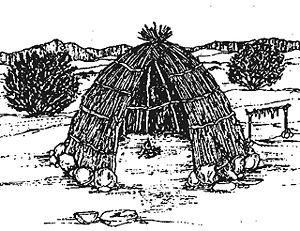
The pre-contact Acjachemen built cone-shaped huts made of willow branches covered with brush or mats made of tule leaves. Known as Kiichas (or wikiups), the temporary shelters were utilized for sleeping or as refuge in cases of inclement weather. When a dwelling reached the end of its practical life it was simply burned, and a replacement erected in its place in about a day's time.
Each clan had its own resource territory and was "politically" independent; ties to other villages were maintained through economic, religious, and social networks in the immediate region. The elite class (composed chiefly families, lineage heads, and other ceremonial specialists), a middle class (established and successful families, and people of disconnected or wandering families and captives of war comprised the three hierarchical social classes.[8] Native leadership consisted of the Nota, or clan chief, who conducted community rites and regulated ceremonial life in conjunction with the council of elders (Puuplem), which was made up of lineage heads and ceremonial specialists in their own right. This body decided upon matters of the community, which were then carried out by the Nota and his underlings. While the placement of residential huts in a village was not regulated, the ceremonial enclosure (Vanquech) and the chief's home were most often centrally-located.[9]
Relatively much is known about the native inhabitants in recent centuries, thanks in part to the efforts of the Spanish explorer Juan Rodríguez Cabrillo, who documented his observations of life in the coastal villages he encountered along the Southern California coast in October of 1542.[10] Fray Gerónimo Boscana, a Franciscan scholar who was stationed at San Juan Capistrano for more than a decade beginning in 1812, compiled what is widely considered to be the most comprehensive study of prehistoric religious practices in the San Juan Capistrano valley.[11] Religious knowledge was secret, and the prevalent religion, called Chinigchinich, placed village chiefs in the position of religious leaders, an arrangement that gave the chiefs broad power over their people.[12] Boscana divided the Acjachemen into two classes: the "Playanos" (who lived along the coast) and the "Serranos" (who inhabited the mountains, some three to four leagues from the Mission).[13] The religious beliefs of the two groups as related to creation differed quite profoundly. The Playanos held that an all-powerful and unseen being called "Nocuma" brought about the earth and the sea, together with all of the trees, plants, and animals of sky, land, and water contained therein.[14] The Serranos, on the other hand, believed in two separate but related existences: the "existence above" and the "existence below." These states of being were "altogether explicable and indefinite" (like brother and sister), and it was the fruits of the union of these two entities that created "...the rocks and sands of the earth; then trees, shrubbery, herbs and grass; then animals..." [15] In 1908, noted cultural anthropologist Alfred L. Kroeber published the following observations with regard to the Juaneño religious observances:
We know that they adore a large bird similar to a kite, which they raise with the greatest of care from the time it is young, and they hold to many errors regarding it.[16] When a new moon shows itself they make a great outcry, which manifests their interest ("negosijo"). If there is an eclipse of the sun or of the moon, they shout with still louder outcries, beating the ground, skins, or mats with sticks, which shows their concerns and uneasiness.[17]
History
Mission Period (1769 – 1833)
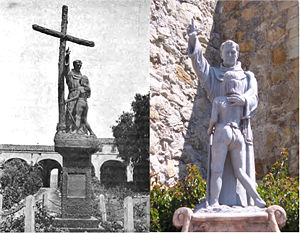
A statue of Father Junípero Serra blessing a Juaneño Indian boy depicts the meeting of the two cultures; a replica of the original rough wooden cross raised during the Mission's founding once adorned this piece (left). The work, which was commissioned by Father O'Sullivan and sculpted by Danish-American artist and sculptor Gutzon Borglum, was erected on August 13, 1914 and dedicated on November 24 in honor of the 201st anniversary of Serra's birth.[18] Father O'Sullivan acted as the subject for Serra, and local resident Clarence Mendelson was the model for the boy.[19]
Father Juan Crespí, as a member of the Portolà Expedition of 1769, authored the first written account of actual interaction between Franciscan friars and the indigenous population in the region that today makes up Orange County, after the group passed through on July 22 of that year. The travelers officially named the area after Santa Maria Magdalena (though it would also come to be called the Arroyo de la Quema and Cañada del Incendio, "Wildfire Hollow").[20] In early 1775, Don Antonio María de Bucareli y Ursúa, Viceroy of New Spain, authorized the establishment of two additional mission sites, one of these to be placed at a logical halfway point between Mission San Diego de Alcalá and Mission San Gabriel Arcángel. The viceroy had already selected the patron saint for the new settlement, "San Juan Capistrano."
- Up from the south slow filed a train,
- Priests and Soldiers of Old Spain,
- Who, through sunlit lomas wound
- With cross and lance, intent to found
- A mission in the wild to John
- Soldier-Saint of Capistran.
- —Saunders and Chase, The California Padres and Their Missions, p. 65
At the proposed site, located approximately 26 leagues (or leguas [21]) north of San Diego, 18 leagues south of San Gabriel, and half a league from the Pacific Ocean, an enramada (arbor) was constructed, two bronze bells were hung from the branch of a nearby tree, and a wooden cross was erected. The grounds were consecrated by Father Fermín Lasuén of Mission San Carlos Borromeo de Carmelo on October 30, 1775 (the last day of the octave after the feast of San Juan Capistrano), near an Indian settlement named Sajavit; thus, La Misión de San Juan Capistrano de Sajavit was founded. Assisting clergy Father Gregório Amúrrio of Mission San Luis Obispo arrived from San Gabriel eight days later with a supply of goods and cattle. Unfortunately, word arrived from San Diego at the same time that a group of natives attacked the mission and brutally murdered one of the missionaries (Father Luís Jayme).[22] Since it was feared at the time that any hostile action by the natives against the few burgeoning outposts might break Spain's tenuous hold on Alta California, the fathers quickly buried the San Juan Capistrano Mission bells. Lieutenant José Francisco Ortega, military leader of the expedition, led all but a small contingent of Spanish soldiers back to El Presidio de San Diego to help quell the uprising; the priests, along with the few remaining soldiers as an escort, gathered up their belongings and fled to the safety of the Presido, where they were given further details of the disaster.[23]
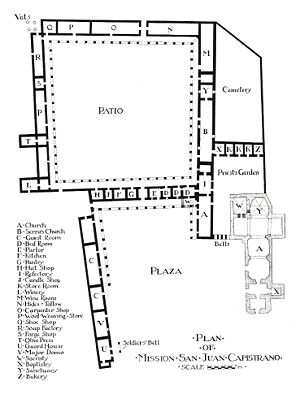
A plan view of the Mission San Juan Capistrano complex (including the footprint of the "Great Stone Church") prepared by architectural historian Rexford Newcomb in 1916. [24]
One year later Father Serra himself, along with Fathers Amúrrio and Pablo de Mugártegui, took up work on the Mission at San Juan Capistrano; the contingent, accompanied by eleven soldiers, arrived on October 30th or 31st, 1776.[25] Upon their return to the site today known as "Mission Vieja," the party excavated the bells and constructed a new arbor; the original wooden cross was, to their surprise, still standing.[26] Father Serra celebrated High Mass in thanksgiving on November 1, 1776 — celebrated ever since as the official founding date.[27] Due to an inadequate water supply the Mission site was subsequently relocated approximately three miles to the west near the Indian village of Acágcheme.[28] The new venue was strategically placed above two nearby streams, the Trabuco and the San Juan. Mission San Gabriel provided cattle and neophyte labor to assist in the development of new the Mission. Father Amúrrio performed the Mission's first baptism on December 19 of that year [29] (a total of 4,639 souls were converted at the Mission between 1776 and 1847 [30]). The first Indian marriage was blessed by Father Mugártegui on the feast of the "Espousals of the Blessed Virgin Mary," January 23, 1777. Father Mugártegui also presided over the first burial ceremony on July 13 (the first burial on Mission grounds would not take place until March 9, 1781).[31] The Registers of Baptisms, Marriages, and Burials are all intact and preserved at the Mission, as is the Confirmation Register (San Juan Capistrano is one of the few Missions to have retained this document). Father Serra visited the Mission for the first time since its founding and administered the Sacrament of Confirmation on October 22.[32] In 1778, the first adobe capilla (chapel) was blessed. It was replaced by a larger, 115-foot (35-meter) long house of worship in 1782, which is regarded as the oldest standing building in California. Known proudly as the "Serra Chapel," it also has the distinction of being the only remaining church in which the padre is known to have officiated ("Mission Dolores" was still under construction at the time of Serra's visit there). Father Serra presided over the confirmations of 213 people on October 12 and 13, 1783; divine services are held there to this day. By the time of the chapel's completion, living quarters, kitchens (pozolera), workshops, storerooms, soldiers' barracks (cuartels), and a number of other ancillary buildings had also been erected, effectively forming the main cuadrángulo (quadrangle).
California's first vineyard was located on the Mission grounds, with the planting of the "Mission" or "Criollo" grape in 1779, one grown extensively throughout Spanish America at the time but with "an uncertain European origin." It was the only grape grown in the Mission system throughout the mid-1800s. The first winery in Alta California was built in San Juan Capistrano in 1783; both red and white wines (sweet and dry), brandy, and a port-like fortified wine called Angelica were all produced from the Mission grape. In 1791, the Mission's two original bells were removed from the tree branch on which they had been hanging for the previous fifteen years and placed within a permanent mounting. Over the next two decades the Mission prospered, and in 1794 over seventy adobe structures were built in order to provide permanent housing for the Mission Indians, some of which comprise the oldest residential neighborhood in California. It was decided that a larger, European-style church was required to accommodate the growing population. Hoping to construct an edifice of truly magnificent proportions, the padres retained the services of maestro albañil (master stonemason) Isídro Aguilár of Culiacán.[35] Aguílar took charge of the church's construction and set about incorporating numerous design features not found at any other California Mission, including the use of a domed roof structure made of stone as opposed to the typical flat wood roof. His elegant roof design called for six vaulted domes (bovedas) to be built.
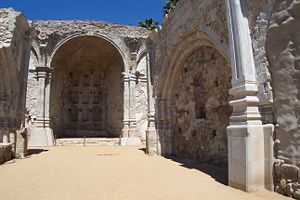
A close-up view of the majestic ruins of Mission San Juan Capistrano's "Great Stone Church," dubbed by architects the "American Acropolis" in reference to its classical Greco-Roman style.[36] "The most important and pretentious building of the whole Mission period..." was modeled after the Byzantine cathedrals scattered throughout Europe and Western Asia.[37]
Work was begun on "The Great Stone Church" (the only chapel building in Alta California not constructed out of adobe) on February 2, 1797. It was laid out in the shape of a cross, measuring 180 feet (55 meters) long by 40 feet (12 meters) wide with 50-foot (15 meter) high walls, and included a 120-foot (37 meter) tall campanile (bell tower) located adjacent to the main entrance.[38] Local legend has it that the tower could be seen for ten miles (16 km) or more, and that the bells could be heard from even farther away.[39] The sandstone building sat on a foundation seven feet thick. Construction efforts required the participation of the entire neophyte population. Stones were quarried from gullies and creek beds up to six miles (10 kilometers) away and transported in carts (carretas) drawn by oxen, carried by hand, and even dragged to the building site. Limestone was crushed into a powder on the Mission grounds to create a mortar that was more erosion-resistant than the actual stones. On the afternoon of November 22, 1800 tremors from the 6.5-magnitude San Diego Earthquake cracked the walls of the rising edifice, necessitating that repair work be performed.[40] Unfortunately, Señor Aguilár died six years into the project; his work was carried on by the padres and their charges, who made their best attempts to emulate the existing construction. Lacking the skills of a master mason, however, led to irregular walls and necessitated the addition of a seventh roof dome. The church was finally completed in 1806, and blessed by Fray Estévan Tapís on the evening of September 7; a two-day long fiesta followed.[41] The sanctuary floors were paved with diamond-shaped tiles, and brick-lined niches displayed the statues of various saints. It was by all accounts the most magnificent in all of California and a three-day feast was held in celebration of this monumental achievement. Tragedy struck the settlement when on the morning of December 8, 1812 (the "Feast Day of the Immaculate Conception of the Blessed Virgin") a series of massive earthquakes shook Southern California during the first Sunday service.[42] The 7.0-magnitude Wrightwood Earthquake racked the doors to the church, pinning them shut. When the ground finally stopped shaking, the bulk of the nave had come crashing down, and the bell tower was completely obliterated. Forty native worshippers who were attending mass and two boys who had been ringing the bells in the tower were buried under the rubble and lost their lives, and were subsequently interred in the Mission cemetery.[43] This was the second major setback the outpost had suffered, and followed severe storms and flooding that had damaged Mission buildings and ruined crops earlier in the year.
The padres immediately resumed holding services in Serra's Church. Within a year a brick campanario ("bell wall") had been erected between the ruins of the stone church and the Mission's first chapel to support the four bells salvaged from the rubble of the campanile. As the transept, sanctuary (reredos), and sacristia (sacristy) were all left standing, an attempt was made to rebuild the stone church in 1815 which failed due to a lack of construction expertise (the latter is the only element that is completely intact today). Consequently, all of the construction work undertaken at the Mission grounds thereafter was of a strictly utilitarian nature. Father José Barona and Father Boscana oversaw the construction of a small infirmary (hospital) building (located just outside the northwestern corner of the quadrangle) in 1814, "for the convenience of the sick." It is here that Juaneño medicine men used traditional methods to heal the sick and injured.[44] Archaeological excavations in 1937 and 1979 unearthed what are believed to be the building's foundations.
On December 14, 1818 the French privateer Hippolyte de Bouchard (also known as Hipólito Bouchard), sailing under the flag of the "United Provinces of Rio de la Plata" (Argentina), brought his ships La Argentina and Santa Rosa to within sight of the Mission; aware that Bouchard (today known as "California's only pirate") had recently conducted raids on the settlements at Monterey and Santa Barbara, Comandante Ruíz had sent forth a party of thirty men (under the leadership of a young Spanish lieutenant named Santiago Argüello) to protect the Mission at first news of the approach on the 13th.[45] Two members of Bouchard's contingent made contact with the garrison soldiers and made their demand for provisions, which was rebuffed, and threats of reprisals made (Lieutenant Argüello replied that if the ships did not sail away the garrison would gladly provide "an immediate supply of shot and shell").[46] In response, "Pirata Buchar" (as he was referred to by the Californios) ordered an assault on the Mission, sending some 140 men and two or three violentos (light howitzer cannon) to take the needed supplies by force.[47] The Mission guards engaged the attackers but were overwhelmed; the marauders looted the Mission warehouses and left minor damage to several Mission buildings in their wake, and reportedly set fire to a few of the outlying straw houses.[48] Reinforcements from Santa Barbara and Los Angeles, led by Comandante Guerra from El Presidio Real de Santa Bárbara, arrived the next day to no avail as the ships had already set sail. Regarded today as one of the more colorful events in the Mission's history, an annual celebration is held to memorialize "The Day that Pirates Sacked the Mission." [49]
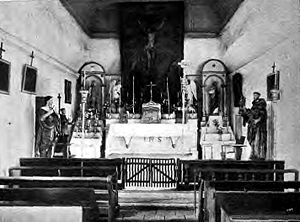
The sanctuary in "Serra's Chapel" (the former "sala") as it looked prior to its being enlarged in 1922. The building is the only extant structure wherein it has been documented that the padre officiated over mass, and is the oldest building in California in continuous use.[50]
Mexico gained its independence from Spain in 1821. The 1820s and 30s saw a gradual decline in the Mission's status. Disease thinned out the once ample cattle herds, and a sudden infestation of mustard weed made it increasingly difficult to cultivate crops. Floods and droughts took their toll as well. But the biggest threat to the Mission's stability came from the presence of Spanish settlers who sought to take over Capistrano's fertile lands. Over time the disillusioned Indian population gradually left the Mission, and without regular maintenance its physical deterioration continued at an accelerated rate. Nevertheless, there was sufficient activity along El Camino Real to justify the construction of the Las Flores Asistencia in 1823. This facility, situated halfway between San Juan Capistrano and the Mission at San Luis Rey, was intended to act primarily as a rest stop for traveling clergy. Around 1820 an estancia (station) was established a few miles north on the banks of the Santa Ana River to accommodate the Mission's sizeable cattle herd. The adobe structure built to house the mayordomo and vaqueros (cowboys) who tended the Mission herds is known today as the Diego Sepúlveda Adobe.[51] Upon his death in 1825, Don José Antonio Yorba I (a prominent Spanish land owner and member of the Portolà Expedition), was buried in the Mission's ceremony in an unmarked grave; a cenotaph was later placed in Yorba's honor.

"Ya Viene El Alba" ("The Dawn Already Comes"), typical of the hymns sung at the Mission.[52]
José María de Echeandía, the first native Mexican to be elected Governor of Alta California, issued his "Proclamation of Emancipation" (or "Prevenciónes de Emancipacion") on July 25, 1826.[53] All Indians within the military districts of San Diego, Santa Barbara, and Monterey who were found qualified were freed from missionary rule and made eligible to become Mexican citizens; those who wished to remain under mission tutelage were exempted from most forms of corporal punishment.[54] Catholic historian Zephyrin Engelhardt referred to Echeandía as "...an avowed enemy of the religious orders." [55] Despite the fact that Echeandía's emancipation plan was met with little encouragement from the neophytes who populated the southern missions, he was nonetheless determined to test the scheme on a large scale at Mission San Juan Capistrano. To that end, he appointed a board of comisianados (commissioners) to oversee the emancipation of the Indians.[56] In reponse to the proclamation, Father Barona refused to take the oath of allegiance to what he saw as the "bogus republic of Mexico" despite the fact that he, along with all but two of the other Spanish missionaries, had previously sworn to the Independence of Mexico.[57] The Mexican government passed legislation on December 20, 1827 that mandated the expulsion of all Spaniards younger than sixty years of age from Mexican territories; Governor Echeandía nevertheless intervened on Barona's behalf in order to prevent his deportation once the law of took effect in California.[58]
Even before Mexico had gained its independence, the Mission had begun its decline.[59] Although Governor José Figueroa (who took office in 1833) initially attempted to keep the mission system intact, the Mexican Congress passed An Act for the Secularization of the Missions of California on August 17, 1833.[60] The Act also provided for the colonization of both Alta and Baja California, the expenses of this latter move to be borne by the proceeds gained from the sale of the mission property to private interests. Mission San Juan Capistrano was the very first to feel the effects of this legislation the following year when, on August 9, 1834 Governor Figueroa issued his "Decree of Confiscation." [61]
Rancho Period (1834 – 1849)
On November 22, 1834 commissioner Juan José Rocha formally acknowledged receipt of the Decree of Confiscation.[62] The final inventory for Mission San Juan Capistrano was compiled by Father José Maria de Zalvidea and four of the commissioners, and included:
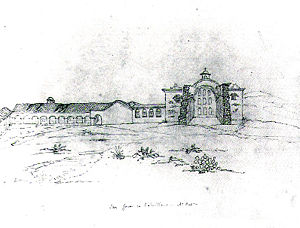
A pencil sketch of Mission San Juan Capstrano drawn in 1850 shows the domes over the sanctuary and transept, and much of the side walls, as being intact at the time.[63] The rendition omits the mounds of rubble that would have been present at the time of Powell's visit. The structure was reduced very nearly to its present state during the 1860s in a misguided attempt to restore the edifice to its original glory.[64]
- buildings ($7,298);
- chapel ($1,250);
- furnishings, tools, and implements ($14,768);
- contents of chapel and sacristy ($15,568);
- ranchos of San Mateo and Mission Vieja ($12,019); and
- library holdings ($490)
for a total valuation of $54,456.[65] Mission credits totaled $13,123 while debts equaled a mere $1,410. The Mission library included three volumes of Juan de Torquemada and twelve volumes of the Año Cristiano. The names of 2,000 neophytes were carried on the Mission rolls. Mission agricultural holdings for that year consisted of:
- 8,000 head of cattle;
- 4,000 sheep;
- 80 pigs;
- 50 horses;
- 9 mules;
- 150 fanegas [66] of maize;
- 20 fanegas of beans; and
- 50 barrels of wine and brandy.[67]
Thereafter, the Franciscans all but abandoned the Mission, taking with them most everything of value, after which the locals plundered many of the Mission buildings for construction materials.[68] According to Bancroft, "The population of San Juan Capistrano in 1834 had decreased to 861 souls, and in 1840 it was probably less than 500 with less than 100 at the pueblo proper; while in its crops San Juan (Capistrano) showed a larger deterioration than any other (missionary) establishment." [69] By 1835, little of the Mission's assets remained, though the manufacture of hides and tallow continued full-swing as described in Richard Henry Dana, Jr.'s classic novel Two Years Before the Mast.[70] The Mission was declared to be "in a ruinous state" and the Indian pueblo dissolved in 1841.[71] San Juan Capistrano was officially designated by Governor Juan B. Alvarado as a secular Mexican town on July 29, at which time those few who still resided at the Mission were granted sections of land to use as their own.[72] Following this change in status, the area around the Mission began to decay rapidly; Santiago Argüello (then prefect of the southern District of Los Angeles) complained to the Commandant of El Presidio de Santa Barbara, Don José de la Guerra y Noriega, that
...the unfortunate missions of San Gabriel and San Juan Capistrano [have] been converted into brothels of the mayordomos.[73]
Four years later, the Mission property was auctioned off under questionable circumstances for $710 worth of tallow and hides (equivalent to $15,000 in 2004 dollars) to Englishman John "Don Juan" Forster (Governor Pío Pico's brother-in-law, whose family would take up residence in the friars' quarters for the next twenty years) and his partner James McKinley.[74] More families would subsequently take up residence in other portions of the Mission buildings. Father José Maria Zalvidea left San Juan Capistrano on or about November 25, 1842 when Mission San Luis Rey de Francia's Father Ibarra died, leaving the Mission without a resident priest for the first time (Zalvidea had been the Mission's sole priest ever since the death of Father Josef Barona in 1831).[75] The first secular priest to take charge of the mission, Reverend José Maria Rosáles, arrived on October 8, 1843;[76] Father Vicente Pascuál Oliva, the last resident missionary, died on January 2, 1848.[77]
California Statehood (1850 – 1900)
Because virtually all of the artwork at the missions served either a devotional or didactic purpose, there was no underlying reason for the mission residents to record their surroundings graphically; visitors, however, found them to be objects of curiosity.[78] During the 1850s a number of artists found gainful employment as draftsmen attached to expeditions sent to map the Pacific coastline and the border between California and Mexico (as well as plot practical railroad routes); many of the drawings were reproduced as lithographs in the expedition reports. The oldest surviving sketch of the Mission, dating back to 1850 and now in the collection of the Bancroft Library, shows that the domes above the stone church's transept, along with the main dome and cupola (lantern house) located above the sanctuary, survived the 1812 'quake.[64] The earliest known photograph of San Juan Capistrano was taken by German-born artist Edward Vischer in 1860.[79] Even before that time, however, the ruins at San Juan Capistrano and its stone church had been romanticized by landscape painters, writers, and historians. The ruins have been compared to those of Greece and Rome, and have at various times been referred to as the "Alhambra of America," the "American Acropolis," and the "Melrose Abbey of the West." [80] Also in 1860, an abortive attempt at restoring the stone church was the cause of its additional disintegration, forcing the domes over the transept and sanctuary to collapse.[81]
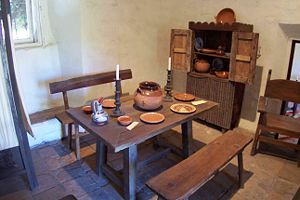
Father José Mut's dining room as it is thought to have looked during his twenty-year stay at the Mission. Some years later, furniture maker and architect Gustav Stickley (the leading spokesperson for the American Arts and Crafts movement) would develop a reputation for fine, hand-crafted furnishings that were inspired by pieces such as these.[82]
A smallpox epidemic swept through the area in 1862, nearly wiping out the remaining Juaneño Indians. President Abraham Lincoln signed a proclamation on March 18, 1865 that restored ownership of the Mission proper to the Roman Catholic Church. The document remains on display in the Mission's barracks cum museum.[83] Ownership of 44.40 acres was conveyed to the Church, for all practical intents being the exact area of land occupied by the original Mission buildings, cemeteries, and gardens.[84] The Mission's sole resident from April, 1866 to April, 1886 was its pastor, Father José Mut. Father Mut made certain changes in order to accommodate his own needs, but little was accomplished to prevent further deterioration of the Mission buildings. Around 1873, some forty Juaneño were still associated with the Mission[85]; however, many of those of mixed Spanish/Mexican and Juaneño heritage were not taken into consideration, and several native villages still existed in the interior valleys.[86] During this same era, the Mission priests established a circuit-riding ministry to these interior villages to the south, and on the other side of the Palomar Mountain Range. A wave of migration by the Juaneño out of San Juan occurred in 1880-1900 as towns in northern Orange County started to form and needed laborers.
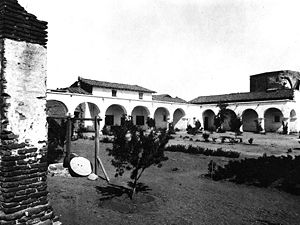
The partially-restored plaza at Mission San Juan Capistrano as it appeared circa 1896. To the right is the sala, which served as the Mission chapel from 1891 until Serra's chapel was restored in the mid-1920s; the building also housed the Forster family during their time at the Mission.[87] Just left of center is Father Mut's former residence, including the loft he had constructed.[88]
The 1880s also saw the appearance of a number of articles on the missions in national publications and the first books on the subject; as a result, a large number of artists did one or more mission paintings, though few attempted series.[89] By 1891 a roof collapse required that the Serra Chapel be abandoned completely. Modifications were made to the original adobe]church (including the addition of a cross-topped espadaña at the south end, a feature that has been retained in the present iteration of the Mission compound) in order to render it suitable for use as a parish church. In 1894, the Atchison, Topeka and Santa Fe Railway constructed a new depot in the emerging "Mission Revival Style" mere blocks from the Mission. It is rumored that the stonework, bricks, and roof tiles were salvaged from the decaying buildings.[90] The following year, a group calling itself the "Landmarks Club of Southern California" (under the direction of acclaimed American journalist, historian, and photographer Charles Fletcher Lummis) made the first real efforts in over fifty years at preserving the Mission and restoring it to its original state.[91] Over 400 tons of debris was cleared away, holes in the walls were patched, and new shake cedar roofs were placed over a few of the derelict buildings; nearly a mile of walkways were repaved with asphalt and gravel as well.[92]
20th century and beyond (1901 – present)
After Father Mut's departure in 1886 the parish found itself without a permanent pastor, and the Mission languished during this period. Father St. John O'Sullivan arrived in San Juan Capistrano in 1910 to recuperate from a recent stroke, and to seek relief from chronic tuberculosis.[93] He became fascinated by the scope of the Mission and soon set to work on rebuilding it a section at a time. Father O'Sullivan's first task was to repair the roof of the Serra Chapel (which was being employed as a granary and storeroom) using sycamore logs to match those that were used in the original work; in the process, the roof of the apse was raised to allow for the inclusion of a window so that natural light could be brought into the space. Other refurbishments were made as time and funds permitted. Arthur B. Benton, a Los Angeles architect, strengthened the chapel walls through the addition of heavy masonry buttresses. The centerpiece of the chapel is its spectacular retablo which serves as the backdrop for the altar. A masterpiece of Baroque art, the altarpiece was hand-carved of 396 individual pieces of cherry wood and overlaid in gold leaf in Barcelona and is estimated to be 400 years old.[94] It was originally imported from Barcelona in 1806 for the Los Angeles cathedral but was never used. It was later donated by Archbishop John Joseph Cantwell of Los Angeles and installed sometime between 1922 and 1924 (the north end of the building had to be enlarged to accommodate this piece due to its height).[41] Although the retablo had been relayered over the centuries, most of the original gilding remains underneath the modern materials (extensive restoration was begun in June, 2006).
The first of many Hollywood productions to use San Juan Capistrano as a backdrop was D.W. Griffith's 1910 western film The Two Brothers (the first film ever shot in Orange County).[95] On January 7, 1911 the film's leading lady, silent film star Mary Pickford, secretly wed fellow actor Owen Moore in the Mission chapel.[95] Artist Charles Percy Austin often stayed in San Juan Capistrano and donated several of his works, the most notable being his memorialization of Pickford's wedding ceremony, appropriately entitled Mary Pickford's Wedding, which he painted after Father O'Sullivan performed the marriage rites.[96] Noted portraitist Joseph Kleitsch also resided at the Mission for a time, and painted a portrait of Father O'Sullivan in 1924 (among other works).[96] The third and final act of John Steven McGroarty's The Mission Play (1911) is set "...amid the broken and deserted walls of Mission San Juan Capistrano (the Mission of the Swallow), in 1847." [97]
Severe flooding destroyed a portion of the Mission's front arcade in 1915, and heavy storms a year later washed away one end of the barracks building (which Father O'Sullivan rebuilt in 1917), incorporating minor modifications such as an ornamental archway in order to make the edifice more closely resemble a church. The Mission grounds were enclosed with a wood picket fence, and beginning on May 9, 1916 a ten-cent admission fee was charged to help defray preservation costs.[98] In 1918 the Mission was given parochial status, with Father O’Sullivan serving as its first modern pastor. It was on April 21 of that year that the San Jacinto Earthquake caused moderate structural damage to some of the buildings. In 1919, author Johnston McCulley created the character "Zorro" and chose Mission San Juan Capistrano as the setting for the first novella, The Curse of Capistrano.[99] In 1920, the "Sacred Garden" was created in the courtyard adjacent to the stone church, and in 1925 the full restoration of the Serra Chapel was completed. Father O'Sullivan died in 1933 and was interred in the Mission cemetery (campo santos) amongst more than 2,000 former inhabitants (mostly Juaneño Indians), who are buried in unmarked graves.[100] Father O'Sullivan's tomb lies at the foot of a Celtic cross the Father himself erected as a memorial to the Mission's builders.
After O’Sullivan's death, Father Arthur J. Hutchinson (another pastor with a love of California history) assumed leadership of the Mission, and played a central role in raising needed funds to continue the Mission’s preservation work.[101] Pastor Hutchinson made key archeological discoveries on the Mission grounds during his tenure (he died on July 27, 1951), after which time his work was continued by the next two pastors, Monsignors Vincent Lloyd-Russell and Paul M. Martin. In 1937, representatives of the U.S. National Park Service's Historic American Buildings Survey (as a part of the [102]) surveyed and photographed the grounds and structures extensively. Their efforts laid the groundwork for future excavation and reconstruction of the west wing industrial complex. Monsignor Martin began a comprehensive preservation effort following the 1987 Whittier Narrows earthquake.[103]
The prestigious World Monuments Fund placed "The Great Stone Church" on its List of 100 Most Endangered Sites in 2002. The most recent series of seismic retrofits at the Mission were completed at a cost of $7.5 million in 2004. About half-a-million visitors, including 80,000 school children, come to the Mission each year.[104]
Other historic designations
- California Historical Landmark #227 — Diego Sepúlveda Adobe Estancia
- ASM International Historical Landmark (1988) — "Metalworking Furnaces"
- World Monuments Fund List of 100 Most Endangered Sites (2002) — "The Great Stone Church"
Mission industries

The cattle brand used at Mission San Juan Capistrano, as registered with the U.S. Land Surveyor's Office in San Francisco.[105][106]
The goal of the missions was, above all, to become self-sufficient in relatively short order. Farming, therefore, was the most important industry of any mission. Barley, maize, and wheat were the principal crops grown at San Juan Capistrano; cattle, horses, mules, sheep, and goats were all raised by the hundreds as well. In 1790 the Mission's herd included 7,000 sheep and goats, 2,500 cattle, and 200 mules and horses. Olives were grown, cured, and pressed under large stone wheels to extract their oil, both for use at the Mission and to trade for other goods. Grapes were also grown and fermented into wine for sacramental use and again, for trading.[107] The specific variety, called the Criolla or "Mission grape," was first planted at the Mission in 1779; in 1783, the first wine produced in Alta California emerged from San Juan Capistrano's winery. Until about 1850, Mission grapes represented the entirety of viticulture in the state. Cereal grains were dried and ground by stone into flour. The Mission's kitchens and bakeries prepared and served thousands of meals each day. Candles, soap, grease, and ointments were all made from tallow (rendered animal fat) in large vats located just outside the west wing. Also situated in this general area were vats for dyeing wool and tanning leather, and primitive looms for weaving. Large bodegas (warehouses) provided long-term storage for preserved foodstuffs and other treated materials.
Three long zanjas (aqueducts) ran through the central courtyard and deposited the water they collected into large cisterns in the industrial area, where it was filtered for drinking and cooking, or dispensed for use in cleaning. The Mission had to fabricate all of its construction materials as well. Workers in the carpintería (carpentry shop) used crude methods to shape beams, lintels, and other structural elements; more skilled artisans carved doors, furniture, and wooden implements. For certain applications bricks (ladrillos) were fired in ovens (kilns) to strengthen them and make them more resistant to the elements; when tejas (roof tiles) eventually replaced the conventional jacal roofing (densely-packed reeds) they were placed in the kilns to harden them as well. Glazed ceramic pots, dishes, and canisters were also made in the Mission's kilns.
Prior to the establishment of the missions, the native peoples knew only how to utilize bone, seashells, stone, and wood for building, tool making, weapons, and so forth. The missionaries discovered that the Indians, who regarded labor as degrading to the masculine sex, had to be taught industry in order to learn how to be self-supportive. The result was the establishment of a great manual training school that comprised agriculture, the mechanical arts, and the raising and care of livestock. Everything consumed and otherwise utilized by the natives was produced at the missions under the supervision of the padres; thus, the neophytes not only supported themselves, but after 1811 sustained the entire military and civil government of California.[108] The foundry at Mission San Juan Capistrano was the first to introduce the Indians to the Iron Age. The blacksmith used the Mission’s Catalan furnaces (California’s first) to smelt and fashion iron into everything from basic tools and hardware (such as nails) to crosses, gates, hinges, even cannon for Mission defense. Iron was one commodity in particular that the Mission relied solely on trade to acquire, as the missionaries had neither the know-how nor the technology to mine and process metal ores.
Mission bells
Bells were vitally important to daily life at any mission. The bells were rung at mealtimes, to call the Mission residents to work and to religious services, during births and funerals, to signal the approach of a ship or returning missionary, and at other times; novices were instructed in the intricate rituals associated with the ringing the mission bells. The original bells were hung from a large nearby tree for some fifteen years, until the chapel bell tower was completed in 1791. What ultimately became of the original bells is not known. New bells were cast in Chile for inclusion in the belfry of "The Great Stone Church." All four of Mission San Juan Capistrano's bells are named and all bear inscriptions as follows (from the largest to the smallest; inscriptions are translated from Latin):[109]
- "Praised by Jesus, San Vicente. In honor of the Reverend Fathers, Ministers (of the Mission) Fray Vicente Fustér, and Fray Juan Santiago, 1796."
- "Hail Mary most pure. Ruelas made me, and I am called San Juan, 1796."
- "Hail Mary most pure, San Antonio, 1804."
- "Hail Mary most pure, San Rafael, 1804."
In the aftermath of the 1812 earthquake, the two largest bells cracked and split open. Due to this damage neither produced clear tones. Regardless, they were hung in the campanario that went up the following year. During the Mission's heyday, a lone bell also hung at the west end of the front corridor, next to an entrance gate which has long since eroded away.[110] One of Father O' Sullivan's companions during his tenure at San Juan Capistrano was José de Gracia Cruz, better known as Acú, who related many stories and legends of the Mission. A descendent of the Juaneño Indians, he served as the Mission's bell ringer until his death in 1924.
On March 22, 1969 President Richard M. Nixon and First Lady Patricia Nixon visited the Mission and rang the Bell of San Rafael. A bronze plaque commemorating the event is set in the bell wall. In celebration of the new Mission church being elevated to minor basilica status in 2000, exact duplicates of the damaged bells were cast by Royal Bellfoundry Petit & Fritsen b.v. of Aarle-Rixtel, the Netherlands utilizing molds made from the originals. The replacement bells were placed in the bell wall and the old ones put on display within the footprint of the destroyed Mission campanile ("bell tower").
Folklore
Legends
The tragedy of the "The Great Stone Church" gave rise to its best-loved legend, that of a young native girl named Magdalena who killed in the collapse. Magdalena lived on the Mission grounds and had fallen in love with an artist named Teófilo. However, the pair was deemed to young to marry by their elders and were forced to carry on their relationship in secret. On that fateful December morning, the repentant Magdalena walked ahead of the procession of worshippers carrying a penitent's candle just as the earthquake struck. Teófilo rushed into the church as the walls and roof tumbled to the ground in a vain attempt to save his lover. When the rubble was cleared the pair was found among the dead, locked in a final embrace. It is said that on moonlight nights one can sometimes make out the face of a young, seemingly illuminated by candlelight, high up in the ruins.[111] Other, less-pervasive legends include that of a facelss monk who haunted the corridors of the original quadrangle, and of a headless soldier who was often seen standing guard near the front entrance.[112]
"The return of the swallows"
The Cliff Swallow (Petrochelidon pyrrhonota) is a migratory bird that spends its winters in Goya, Argentina but makes the 6,000-mile (10,000-kilometer) trek north to the warmer climes of the American Southwest in springtime. According to legend the birds, who have visited the San Juan Capistrano area every Summer for centuries, first took refuge at the Mission when an irate innkeeper began destroying their mud nests (the birds also frequent the Mission San Carlos Borromeo de Carmelo).[113] The Mission's location near two rivers made it an ideal location for the swallows to nest, as there was a constant supply of the insects on which they feed, and the young birds are well-protected inside the ruins of the old stone church.
A 1915 article in Overland Monthly magazine made note of the birds' annual habit of nesting beneath the Mission's eaves and archways from Spring through Fall, and made the swallows the "signature icon" of the Mission; Father O'Sullivan utilized interest in the phenomenon to generate opublic interest in restoration efforts during his two decades in residence.[114] One of bell ringer Acú's most colorful tales was that the swallows (or las golondrinas, as he called them) flew over the Atlantic Ocean to Jerusalem each winter, carrying small twigs on which they could rest atop the water along the way. On March 13, 1939 a popular radio program was broadcast live from the Mission grounds, announcing the swallows' arrival. Composer Leon René was so inspired by the event that he penned the song "When the Swallows Come Back to Capistrano" in tribute.[91] During its initial release the song spent several weeks atop the Your Hit Parade charts. The song has been recorded by such musicians as The Ink Spots, Fred Waring, Guy Lombardo, and Glenn Miller. A glassed-off room in the Mission has been designated in René's honor and displays the upright piano on which he composed the tune, the reception desk from his office and several copies of the song's sheet music and other pieces of furniture, all donated by René's family.
Each year the City of San Juan Capistrano sponsors the Fiesta de las Golondrinas, a week-long celebration of this auspicious event.[115] Tradition has it that the main flock arrives on March 19 (Saint Joseph's Day), and flies south on Saint John's Day, October 23.
- When the swallows come back to Capistrano
- That's the day you promised to come back to me
- When you whispered, "Farewell," in Capistrano
- 'twas the day the swallows flew out to sea
- —excerpt from "When the Swallows Come Back to Capistrano" by Leon René
California pepper tree
The largest California pepper tree (Schinus molle) in the United States resided at Mission San Juan Capistrano until 2005, when it was felled due to illness.[116] The 57-foot (17-meter)tall specimen, planted in the 1870s, was typical of the early California landscape; it was also listed in the National Register of Big Trees. The oldest pepper tree in California resides in the courtyard of Mission San Luis Rey de Francia.[117]
Notes

The "Alemany Plat" prepared by the U.S. Land Surveyor's Office to define the property restored to the Catholic Church by the Public Land Commission, later confirmed by presidential proclamation on March 18, 1865.[118]

President Abraham Lincoln's signature as it appeared on the United States Patent that restored the Mission property to the Catholic Church in 1865. This is one of the few documents that the President signed as "A. Lincoln" instead of his customary "Abraham Lincoln." [83]
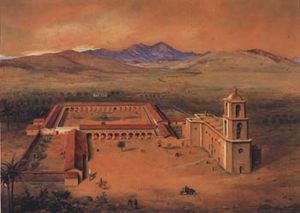
An 1894 painting by Frederick Behre features a wildly-improbable steeple over the entrance of San Juan Capistrano's "Great Stone Church" (it was incorrectly believed to portray the way the church looked before the 1812 earthquake; archaeological excavations in 1938 revealed that the steeple placement as shown in the painting was impossible).[89] The landscape in the background of this painting was later modified by John Gutzon Borglum.[119] Watercolor and gouache.
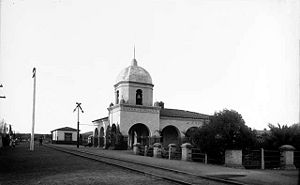
One of the earliest examples of "Mission Revival Style" architecture, the Atchison, Topeka and Santa Fe Railway depot in San Juan Capistrano (with its 40-foot [12-meter] high dome and bell) was considered to be one of the railroad's finest when it was completed on October 8, 1894; it officially entered service on October 27 of that year.[120] The San Juan Capistrano station has remained in use and today is served by Amtrak, the national railroad passenger system, and Metrolink, a commuter railroad.
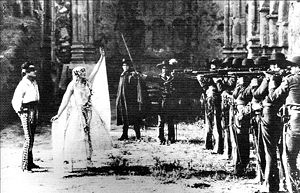
Mary Astor and Gilbert Roland starred in George Fitzmaurice's 1927 motion picture Rose of the Golden West, shot on location on the Mission grounds.[121] The film's penultimate scene (shown here) is set amidst the ruins of "The Great Stone Church."
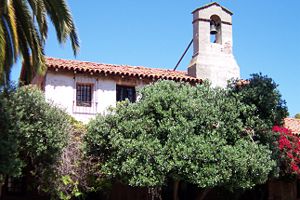
This 2nd-story refectory and bell tower was constructed atop the former carpentry shop on the north wing of the Mission's quadrangle in 1936.[122]
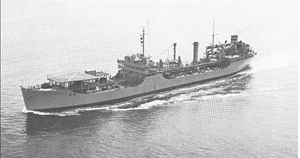
USNS Mission Capistrano (T-AO-112) is the second of twenty-seven Mission Buenaventura-class fleet oilers built during World War II for service in the United States Navy. She is the only U.S. Naval vessel to bear the name, and today serves as part of the U.S. "Ready Reserve Force" fleet.
- ↑ Paddison, p. 333: The first undisputable archaeological evidence of human presence in California dates back to circa 8,000 BCE.
- ↑ Jones and Klar 2005, p. 53: "Understanding how and when humans first settled California is intimately linked to the initial colonization of the Americas."
- ↑ After Kroeber, 1925
- ↑ Kroeber 1925, p. 636: Kroeber estimated that the native population in the immediate vicinity of San Juan Capistrano was approximately 1,000 in 1770.
- ↑ As with other Spanish names given to the indigenous tribes they encountered, the appellation Juaneño does not necessarily identify a specific ethnic or tribal group.
- ↑ Sparkman, p. 189: Linguistically, the Acjachemen tongue is a dialect of the larger Luiseño language, which itself is derived from the Takic language family (Luiseño, Juaneño, Cupeño, and Cahuilla Indians all belong to the Cupan subgroup), a part of the Uto-Aztecan (Shoshone) linguistic stock (this language is sometimes referred to as "Southern California Shoshonean"); however, the language at Capistrano and Soboba differed "considerably from that of the remainder of the Luiseños, and by some the people of these places are not included among the Luiseños."
- ↑ O'Neil, pp. 68–78
- ↑ Bean and Blackburn, pp. 109–111
- ↑ Boscana, p. 37
- ↑ Yenne, p. 8
- ↑ Rawls, p. 26: Boscana deduced that the "Indians of California may be compared to a species of monkey" and described the native beliefs and customs as "horrible," "ludicrous," and "ridiculous."
- ↑ Kelsey, p. 3
- ↑ Hittell, p. 746
- ↑ Hittell, p. 749
- ↑ Hittell, pp. 746-747
- ↑ Kroeber 1908, p. 11. According to Kroeber, the large bird was either the eagle or condor, as was the case with the Luiseño and Diegueño peoples.
- ↑ Kroeber 1908, p. 11. The "outcry" at the appearance of a new moon is more fully described by Boscana.
- ↑ Hallan-Gibson, p. 123; Stern and Miller, p. 65: The statue was originally placed in the plaza near the Mission entrance and moved to its current location near the campanile in the 1920s, after the Mission compound had been enclosed.
- ↑ Hallan-Gibson, p. 123
- ↑ Kelsey, p. 9
- ↑ A Dictionary of Units of Measurement: The legua, or "Spanish League" was originally set as a fixed unit of distance of 5,000 varas (in California, the vara was considered equal to 33 inches [3.82 centimeters]). Using the traditional Spanish definition, a legua would equate to 2.597 miles (13.712 feet), or 4179.4 meters. Technically, this unit was abolished by King Philip II in 1568, but nonetheless remained in rather wide use, especially in the Americas.
- ↑ Wright, p. 37; Yenne, p. 72
- ↑ Engelhardt 1922, p. 6
- ↑ Newcomb, p. 15
- ↑ Engelhardt 1922, p. 6: "It was owing to the animosity of Rivera...that the two Fathers Lasuén and Amúrrio were compelled to remain idle for nearly a year. Peremptory orders from Viceroy [Antonio María de Bucareli y Ursúa] Bucareli at last put an end to the chicanery."
- ↑ Saunders and Chase, p. 22
- ↑ "Historic San Juan Mission": The founding document on display within the Mission is also the only known surviving founding paper signed by Father Serra.
- ↑ Kelsey, p. 10: According to a report filed in 1782 by Father Mugártegui, "...the site was transferred to that which it occupies today, where we have the advantage of secure water...this transfer was made on October 4, 1776."
- ↑ Engelhardt 1922, p. 213
- ↑ Engelhardt 1922, p. 183
- ↑ Engelhardt 1922, p. 195
- ↑ Engelhardt 1922, p. 22
- ↑ Newcomb, p. 16
- ↑ Krell, p. 155
- ↑ Camphouse, p. 30
- ↑ Ruscin, p. 72
- ↑ Engelhardt 1922, p. 28
- ↑ Krell, pp. 154, 275: The cruciform design is shared only with the extant chapel at Mission San Luis Rey de Francia, which makes the two structures unique among the Alta California missions in this regard.
- ↑ O'Sullivan, p. 14
- ↑ Engelhardt 1922, p. 39
- ↑ Jump up to: 41.0 41.1 Yenne, p. 75
- ↑ Ruscin, p. 72
- ↑ Engelhardt 1922, p. 251
- ↑ Engelhardt 1922, p. 57
- ↑ Bancroft, vol. ii, p. 240
- ↑ Stern and Miller, p. 50; Yenne, p. 77
- ↑ Jones p. 170
- ↑ Bancroft, vol. ii, p. 241; Miller and Stern, p. 50: Sir Peter Corney, commander of the Santa Rosa, later reported that, "We found the town well-stocked with everything but money, and destroyed much wine and spirits and all the public property, set fire to the King's stores, barracks, and governor's house, and about two o'clock we marched back though not in the order that we went, many of the men being intoxicated."
- ↑ Yenne, p. 77. There is a great contrast between the legacy of Bouchard in Argentina versus his reputation in the United States. In Buenos Aires, Bouchard is honored as a brave patriot, while in California he is most often remembered as a pirate, and not a privateer.
- ↑ Young, p. 23
- ↑ Engelhardt 1922, p. 89
- ↑ Engelhardt 1922, p. 30
- ↑ Engelhardt 1922, p. 80
- ↑ Bancroft, vol. i, pp. 100-101: Bancroft postulated that the motives behind the issuance of Echeandía's premature decree had more to do with the his desire to appease "...some prominent Californians who had already had their eyes on the mission lands..." than they did with concerns regarding the welfare of the natives.
- ↑ Stern and Miller, pp. 51-52
- ↑ Bancroft, vol. iii, pp. 322; 626
- ↑ Engelhard 1922, p. 223: Fathers Antonio Peyri and Francisco Suñer did not pledge their allegiance to the new Republic.
- ↑ Engelhard 1922, p. 223: On June 7, 1829 Echeandía wrote, "Fr. José Barona; age, sixty-six years; broken in health; decided to take the oath in 1826 as far as compatible with his religious profession and as long as he remained in the Mexican Republic."
- ↑ Stern and Miller, p. 51: American businessman Alfred Robinson, who visited the settlement in 1829, wrote, "This establishment was founded in the year 1776 and though in its early years was the largest in the country, yet it is now in a dilapidated state and the Indians are much neglected."
- ↑ Yenne, p. 19
- ↑ Engelhardt 1922, p. 114
- ↑ Engelhardt 1922, p. 116
- ↑ Stern and Miller, p. 87
- ↑ Jump up to: 64.0 64.1 Krell, p. 157
- ↑ Engelhardt 1922, p. 115
- ↑ A Dictionary of Units of Measurement: A fanega is equal to 1.575 U.S. bushels.
- ↑ Engelhardt 1922, pp. 182, 185
- ↑ Robinson, p. 42: In spite of this neglect, the Indian town at San Juan Capistrano (along with those at San Dieguito and Las Flores) continued on for some time under a provision in Gobernador Echeandía's 1826 Proclamation that allowed for the partial conversion of missions to pueblos.
- ↑ Engelhardt 1922, p. 114
- ↑ Young, p. 24: In May, 1935 Dana wrote that San Juan was "the only romantic place on the coast."
- ↑ Hallan-Gibson, p. 28
- ↑ Engelhardt 1922, p. 144
- ↑ Engelhardt 1922, p. 155: "¿Porqué no se echa una mirada a las desfortunados misiones de San Gabriel y San Juan Capistrano? Estas se han convertido en lupanares de los señores mayordomos." — from the De la Guerra Papers, vol. vii, pp. 82-83.
- ↑ Engelhardt 1922, p. 157
- ↑ Engelhardt 1922, p. 182
- ↑ Engelhardt 1922, p. 188
- ↑ Engelhardt 1922, p. 227
- ↑ Stern and Miller, p. 85
- ↑ Engelhardt 1922, p. 220
- ↑ Saunders and Chase, p. 65; Fradkin, p. 51
- ↑ Fradkin, p. 51: Father O'Sullivan (who in time became an authority on the old stone church) wrote in 1912, "The venerable crumbling walls have been studied and painted sympathetically by artists from near and far, measured with enthusiasm by architects, builders have stood in open-mouth admiration of the massive concrete work done by the padres a hundred years before it dawned on the modern builder that the same, with steel reinforcement, was the proper mode for California."
- ↑ Cathers, p. 45
- ↑ Jump up to: 83.0 83.1 Engelhardt 1922, p. 169
- ↑ Robinson, pp. 31-32: The area shown is that stated in the Corrected Reports of Spanish and Mexican Grants in California Complete to February 25, 1886 as a supplement to the Official Report of 1883-1884. Patents for each mission were issued to Archbishop Joseph Sadoc Alemany based on his claim filed with the Public Land Commission on February 19, 1853 (note that the present-day Mission complex covers a mere 10 acres).
- ↑ Ames, p. 5
- ↑ Ames, p. 6: As late as the 1930s, some 300 Mission-descended Indians were known to be living in the Orange County area.
- ↑ Hallan-Gibson, p. 42
- ↑ The loft space was used for storage of the Mission baptismal, confirmation, marriage, and death records after Father Mut's departure.
- ↑ Jump up to: 89.0 89.1 Stern and Miller, p. 92
- ↑ Duke, p. 241
- ↑ Jump up to: 91.0 91.1 Leffingwell, p. 39
- ↑ Stern and Miller, p. 60
- ↑ Wright, p. 39
- ↑ Hallan-Gibson, p. 75
- ↑ Jump up to: 95.0 95.1 Stern and Miller, p. 63
- ↑ Jump up to: 96.0 96.1 Stern and Miller, p. 78
- ↑ "The Mission Play"
- ↑ Hallan-Gibson, p. 71: In 1917 the fence was replaced by an adobe wall, which was completed on September 1.
- ↑ Yenne, P. 79
- ↑ "Historic San Juan Mission"
- ↑ Hallan-Gibson, p. 84
- ↑ Historic Sites Act of 1935, 49 Stat. 666; 16 U.S.C. sections 461-467.
- ↑ Krell, p. 156
- ↑ Stern and Miller, p. 70
- ↑ Engelhardt 1922, p. 86
- ↑ Hallan-Gibson, p. 13: Around 1811 (at the height of its prosperity) Mission San Juan Capistrano owned some 14,000 head of cattle, 16,000 sheep, and 740 horses.
- ↑ Engelhardt 1922, pp. 10-11: Father Francisco Palóu at one point reported, "As it had been observed from the beginning of the Mission that the whole county around there was well covered with wild grapevines, so that in places they resemble vineyards, the Fathers began to plant some domesticated shoots from Lower California, and have already succeeded in obtaining wine, not only for Holy Mass, but also for the table. They have also raised various Spanish fruits, such as pomegranates, peaches, and apricots, etc. Garden products also thrive very well."
- ↑ Engelhardt 1922, p. 211
- ↑ Engelhardt 1922, p. 242
- ↑ O'Sullivan, p. 20
- ↑ Stern and Miller, pp. 49-50
- ↑ Stern and Miller, p. 68
- ↑ Krell, p. 162
- ↑ Yenne, p. 78
- ↑ The 2007 film The Simpsons Movie pays an homage of sorts to this tradition by referring to the annual "Swallows' return to Springfield."
- ↑ "Schinus molle"
- ↑ Young, p. 18
- ↑ Engelhardt 1922, p. 167: The document was recorded on December 15, 1875 by the County Recorder of Los Angeles at the request of the Right Reverend Bishop T. Amat.
- ↑ Stern and Miller, p. 95
- ↑ Gustafson and Serpico, p. 192: Much of the stone, bricks, and roof tiles were gathered from the decaying Mission, preservations efforts having not yet begun at the time of the station's construction.
- ↑ Hallan-Gibson, p. 73
- ↑ Leffingwell, pp. 36-37
